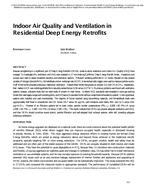Description
Because airtightening is a significant part of Deep Energy Retrofits (DERs), concerns about ventilation and Indoor Air Quality (IAQ) have emerged. To investigate this, ventilation and IAQ were assessed in 17 non-smoking California Deep Energy Retrofit homes. Inspections and surveys were used to assess household activities and ventilation systems. Pollutant sampling performed in 12 homes included six-day passive samples of nitrogen dioxide (NO2), formaldehyde and air exchange rate (AER); time-resolved data loggers were used to measure particle counts. Half of the homes provided continuous mechanical ventilation. Despite these homes being twice as airtight (3.0 and 7.6 ACH50, respectively), their median AER was indistinguishable from naturally vented homes (0.36 versus 0.37 hr–1). Numerous problems were found with ventilation systems; however, pollutant levels did not reach levels of concern in most homes. Ambient NO2 standards were exceeded in some gas cooking homes that used legacy ranges with standing pilots, and in Passive House-style homes without range hoods exhausted to outside. Cooking exhaust systems were installed and used inconsistently. The majority of homes reported using low-emitting materials, and formaldehyde levels were approximately half those in conventional new CA homes (19.7 versus 36 μg/m3), with emissions rates nearly 40% less (12.3 versus 20.6 μg/m2/hr.). Presence of air filtration systems led to lower indoor particle number concentrations (PN>0.5: 8.80E+06 PN/m3 versus 2.99E+06; PN>2.5: 5.46E+0.5 PN/m3 versus 2.59E+05). The results indicate that DERs can provide adequate ventilation and IAQ, and that DERs should prioritize source control, particle filtration and well-designed local exhaust systems, while still providing adequate continuous ventilation.
Citation: IAQ Conference: IAQ 2013: Environmental Health in Low Energy Buildings
Product Details
- Published:
- 2013
- Number of Pages:
- 6
- File Size:
- 1 file , 360 KB
- Product Code(s):
- D-2013IAQConf-79




